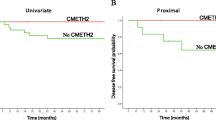Abstract
PURPOSE: AB. B. subset of sporadic colorectal carcinomas show microsatellite instability, usually as a result of biallelic hMLH1 gene promoter methylation. Synchronous tumors occur in up to 5 percent of patients with colorectal cancer, but their cause is poorly understood. We hypothesized that in the setting of sporadic microsatellite instability cancers, synchronicity may reflect a global predisposition of colorectal epithelium toward tumor development because of gene hypermethylation. METHODS: We identified 14 individuals with 33 synchronous cancers from a series of 362 patients with 381 sporadic colorectal cancers. We then analyzed the synchronous lesions for microsatellite status, hMLH1 protein expression, and hMLH1 promoter methylation. RESULTS: Seven of 33 synchronous tumors (21 percent) showed microsatellite instability, compared with 36 of 348 solitary tumors (10.3 percent, P = 0.06). The 14 patients with synchronous tumors were significantly older than those with solitary tumors (mean age 79.4 vs. 68.2 years, P = 0.01), and 5 of these patients had at least one microsatellite instability tumor. However, only one patient harbored synchronous tumors that were all of the microsatellite instability type. Methylation of the hMLH1 promoter was seen in 9 synchronous cancers from 27 assessable lesions in 7 patients and was associated with microsatellite instability (P = 0.01), right-sidedness (P = 0.01), and loss of expression of hMLH1 (P = 0.03). Only one case showed methylation in all synchronous tumors, whereas in five cases synchronous tumors showed different methylation status within the one individual. CONCLUSION: Our data suggest that synchronous tumors arise as independent events and that the slightly greater frequency of synchronous tumors in individuals with microsatellite instability cancers is likely to be a chance event reflecting the older age of these individuals rather than arising from a predisposition toward cancer as a result of global hypermethylation of colorectal epithelium.
Similar content being viewed by others
References
RA Lothe P Peltomaki GI Meling et al. (1993) ArticleTitleGenomic instability in colorectal cancer Cancer Res 53 5849–5852
M Aarnio H Mustonen JP Mecklin HJ Jarvinen (1998) ArticleTitlePrognosis of colorectal cancer varies in different high-risk conditions Ann Med 30 75–80
H Kim J Jen B Vogelstein SR Hamilton (1994) ArticleTitleClinical and pathological characteristics of sporadic colorectal carcinomas with DNA replication errors in microsatellite sequences Am J Pathol 145 148–156
JG Herman A Umar K Polyak et al. (1998) ArticleTitleIncidence and functional consequences of hMLH1 promoter hypermethylation in colorectal carcinoma Proc Natl Acad Sci USA 95 6870–6875
T Kimura H Iwagaki S Fuchimoto A Hizuta K Orita (1994) ArticleTitleSynchronous colorectal carcinomas Hepatogastroenterology 41 409–412
G Slater AH Aufses SuffixJr A Szporn (1990) ArticleTitleSynchronous carcinoma of the colon and rectum Surg Gynecol Obstet 171 283–287
M Adloff JP Arnaud R Bergamaschi M Schloegel (1989) ArticleTitleSynchronous carcinoma of the colon and rectum Am J Surg 157 299–302
ML Caruso R Armentano (1998) ArticleTitleMultiple synchronous colorectal carcinomas Anticancer Res 18 225–229
AJ Greenstein G Slater TM Heimann DB Sachar AH Aufses SuffixJr (1986) ArticleTitleA comparison of multiple synchronous colorectal cancer in ulcerative colitis, familial polyposis coli, and de novo cancer Ann Surg 203 123–128
RJ Fitzgibbons SuffixJr HT Lynch GV Stanislav et al. (1987) ArticleTitleRecognition and treatment of patients with hereditary nonpolyposis colon cancer (Lynch syndromes I and II) Ann Surg 206 289–295
WM Brueckl T Limmert T Brabletz et al. (2000) ArticleTitleMismatch repair deficiency in sporadic synchronous colorectal cancer Anticancer Res 20 4727–4732
HF Vasen P Watson JP Mecklin HT Lynch (1999) ArticleTitleNew clinical criteria for hereditary nonpolyposis colorectal cancer (HNPCC, Lynch syndrome) proposed by the International Collaborative group on HNPCC Gastroenterology 116 1453–1456
S Warren O Gates (1932) ArticleTitleMultiple primary malignant tumors. A survey of the literature and statistical study Am J Cancer 16 1358–1414
CG Moertal JA Bargen MB Dockerty (1958) ArticleTitleMultiple carcinomas of the large intestine. A review of the literature and a study of 261 cases Gastroenterology 34 85–98
R Ward A Meagher I Tomlinson et al. (2001) ArticleTitleMicrosatellite instability and the pathological features of sporadic colorectal cancer Gut 48 821–829
CR Boland SN Thibodeau SR Hamilton et al. (1998) ArticleTitleA National Cancer Institute workshop on microsatellite instability for cancer detection and familial predisposition Cancer Res 58 5248–5257
JG Herman JR Graff S Myöhänen BD Nelkin SB Baylin PCR Methylation-specific (1996) ArticleTitleA novel PCR assay for methylation status of CpG islands Proc Nat Acad Sci USA 93 9821–9826
SA Kuismanen MT Holmberg R Salvaara et al. (1999) ArticleTitleEpigenetic phenotypes distinguish microsatellite-stable and –unstable colorectal cancers Proc Nat Acad Sci USA 96 12661–6
M Toyota N Ahuja M Ohe-Toyota JG Herman SB Baylin JP Issa (1999) ArticleTitleCpG island methylator phenotype in colorectal cancer Proc Nat Acad Sci USA 96 8681–8686
M Toyota M Ohe-Toyota N Ahuja JP Issa (2000) ArticleTitleDistinct genetic profiles in colorectal tumors with or without the CpG island methylator phenotype Proc Natl Acad Sci U S A 97 710–715
M Pedroni MG Tamassia A Percesepe et al. (1999) ArticleTitleMicrosatellite instability in multiple colorectal tumors Int J Cancer 81 1–5
RJ Koness TC King S Schechter SF McLean C Lodowsky HJ Wanebo (1996) ArticleTitleSynchronous colon carcinomas Ann Surg Oncol 3 136–143
K Eguchi T Yao T Konomoto K Hayashi M Fujishima M Tsuneyoshi (2000) ArticleTitleDiscordance of p53 mutations of synchronous colorectal carcinomas Mod Pathol 13 131–139
J Breivik G Gaudernack (1999) ArticleTitleCarcinogenesis and natural selection Adv Cancer Res 76 187–212
Author information
Authors and Affiliations
About this article
Cite this article
Norrie, M.W., Hawkins, N.J., Todd, A.V. et al. The Role of hMLH1 Methylation in the Development of Synchronous Sporadic Colorectal Carcinomas. Dis Colon Rectum 45, 674–680 (2002). https://doi.org/10.1007/s10350-004-6266-1
Issue Date:
DOI: https://doi.org/10.1007/s10350-004-6266-1




